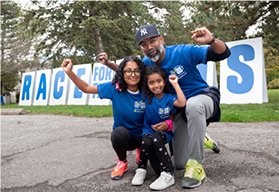‘I won the lottery that day’: How focused ultrasound transformed Andy Hodgson’s life

Navigating Complex Challenges
When Andy Hodgson was first dating his now-wife, Kim, he would write her notes.
“I loved writing her letters,” he says. “Just telling her how much I loved her.”
But, until November 2020, Andy hadn’t written Kim a note in years.
Diagnosed with essential tremor
Andy has had a tremor since he was young; his first memory of it is his lip shaking when he was 14. It got progressively worse as he got older, when his hands would start to shake and some simple tasks such as eating or writing became difficult. He was eventually diagnosed with an essential tremor in his early 20s.
“It’s scary, somebody telling you there’s something wrong with you. And then telling you it’s going to get worse; that the best you have it is right now. And there’s no cure,” says Andy.
It was difficult for Andy. He felt uncomfortable talking about the tremor and hid it from everyone but family and close friends.
“He didn’t want to do things like going out for dinner,” Kim says. “Even when we first started dating, we didn’t go out with other people that much. He didn’t want to eat in front of people because his hand shook.”
Andy, a grade 7 and 8 teacher, says he would eat lunch in his classroom instead of the staff room, would go out for drinks with co-workers on a Friday night but not eat anything — even though he was hungry — because he didn’t want people to see his hand shaking.
Driving Innovation into Action
And then one day while he and Kim were watching the news, there was a segment about a procedure being performed at Sunnybrook that could help patients with essential tremor.
“I almost cried,” Andy says. “Here was something, maybe, something for me.”
Andy reached out to his family doctor, who helped Andy enroll in a focused ultrasound trial at Sunnybrook. Focused ultrasound is a non-invasive, image-guided surgical technology that uses ultrasound energy to target specific areas of the brain and body in the treatment. For treatment of essential tremor, high-intensity focused ultrasound waves lesion the brain cells responsible for the tremor, which can significantly improve symptoms for patients.
Sunnybrook is a global leader in focused ultrasound research and clinical trials.
“In May 2012, Sunnybrook was the first centre in Canada to perform a focused ultrasound procedure for essential tremor,” says Dr. Nir Lipsman, neurosurgeon and director of Sunnybrook’s Harquail Centre for Neuromodulation. “Ten years later, we’re more committed than ever to this breakthrough technology. We have expanded our clinical and research program and are investigating focused in ultrasound in several other brain disorders, including Alzheimer’s disease, major depression, ALS, and brain cancer.”
Seeing the video about a possible treatment for essential tremor was the first time Andy had thought there might be a way to stop his tremor, but it wasn’t until he got a phone call from Sunnybrook that he’d been accepted into a clinical trial that it felt real. He excitedly told Kim, who wasn’t quite as excited as he was just yet.
“He did the excitement, I did the worrying,” Kim says. She was nervous about the possible side effects of having the surgery, but Andy kept telling her it didn’t matter.
“‘I won the lottery that day’: How focused ultrasound transformed Andy Hodgson’s life,” Andy says. “Up until that point, there had been nothing I could do. I was tired, I was exhausted. And, suddenly, there’s hope.”
Andy had his focused ultrasound procedure on Nov. 16, 2020—he was the 200th focused ultrasound patient at Sunnybrook—and he walked out of the operating room with a steady hand. “After the operation finished, [Dr. Nir Lipsman] hands me a glass of water,” Andy says. “I haven’t held a glass of water with one hand in 20 years. I remember that moment because I was frightened, thinking if I move it and find out the operation didn’t work, then this is it.”
But Andy was able to drink the glass of water with one hand.
“I don’t know how to describe it,” he says. “I was back.”
Expert Collaboration for Compassionate Patient Care
It was a few weeks later, while he was home recovering, that he picked up a pen to write a note to Kim for the first time in many years. He texted it to her so she could read it at work.
“I get this ‘ding’ and I’m thinking something’s wrong because he’s home by himself after having brain surgery,” Kim says. “So I pick up my phone, see the note, and I almost cried. It was so nice because the old Andy was back, and you could just tell he was so happy.”

As part of a clinical trial exploring focused ultrasound for bilateral essential tremor, Andy has since received treatment for his right hand as well (his non-dominant side), which was also successful. He says he has some rebound tremor, which is quite normal, but it’s minimal compared to what it was before the procedure, unnoticeable to most people.
And now, Andy says he’s much more comfortable telling his story.
“The team at Sunnybrook, the different neurosurgeons and neurologists—they’ve given me the words, the understanding that it’s not my fault,” Andy says.
He says he doesn’t mind if someone notices the tremor and asks about it. He wants to talk about it in the hopes that maybe someone else who needs it will hear about focused ultrasound.
“I love sharing my story. I want them to know, if they know somebody or it happens to them, talk to your doctor,” he says. “There’s hope.”
Following treatment, Andy can eat soup without spilling now; he’s experimenting with new baking recipes and he’s writing all the notes he wants. He doesn’t feel like he has to hide anymore, thanks to focused ultrasound and Sunnybrook.
“I owe them so much,” he says. “They’re my heroes.”
Learn more about FUSLearn about the 10 years of FUS in Brain Sciences at Sunnybrook










